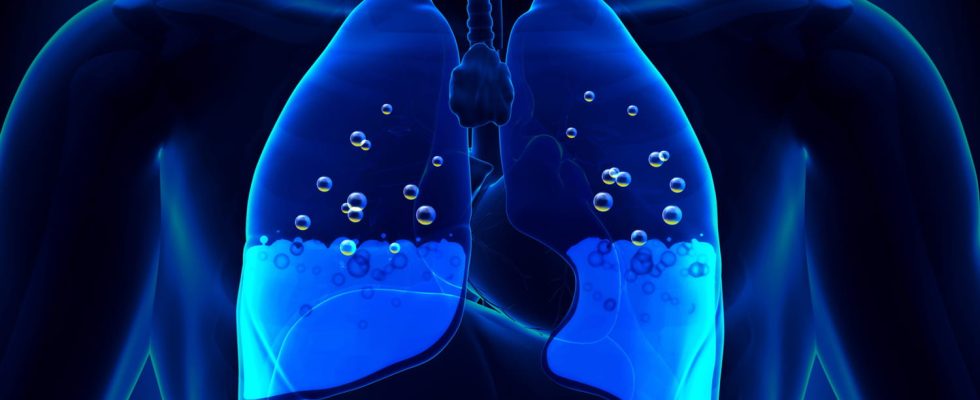Acute pulmonary edema (pulmonary edema or PAO), caused by heart disease, is a medical emergency. What are the causes ? Symptoms ? Cough ? How to treat it?
Acute pulmonary edema is defined as the presence of fluid in the alveoli. The vast majority of pulmonary edemas are of cardiac origin. It’s about a medical emergency. What causes pulmonary edema? What are the consequences ? How to cure it?
What is the definition of pulmonary edema?
Like all edemas, acute pulmonary edema, OAP or acute pulmonary edema, is characterized by an abnormal and sudden accumulation of fluid in the lungmore precisely in the pulmonary alveoli (small pockets where gas exchange with the blood takes place) “while normally there is no liquid in itsimply air“, immediately advances Dr Stéphane Boulé, cardiologist and member of the French Federation of Cardiologywhich adds:This is a medical emergency.“However, PAO is not a disease of the lungs.”This is the result of heart disease. This fits into what is called heart failure“.
What causes pulmonary edema?
→ Heart dysfunction. An OAP can happen”because ofheart dysfunction which no longer effectively assumes its role as a pump for various reasons“, explains Stéphane Boulé. “Whatever the cause, if the heart no longer pumps blood properly, it then tends to stagnate upstream, in the lung vessels. If the blood pressure in these vessels becomes too high, then there will be a leak of fluid from these vessels into the alveoli of the lung.“
→ Heart damage. While the vast majority of OAPs are of cardiac originsome arise from a lesion and are therefore called Lesional OAPs. These are caused by trauma caused by rupture of the membrane located between the vessels and the alveoli of the lungs: we speak of ARDS (acute respiratory distress syndrome). The presence of liquid in the pulmonary alveoli will be responsible for a reduction in the quality of gas exchange, leading to significant breathing difficulties, depending on the speed of constitution and the importance of the liquid invasion.
→ Infectious or toxic pneumonia
→ Trauma
Who are the people most at risk?
Elderly people with a history of heart attack and those with risk factors (smoking, alcoholism, diabetes) are most at risk.
What symptoms to recognize lung edema?
Acute pulmonary edema is manifested by:
- of the sudden onset breathing difficulties with increased respiratory rate
- increased discomfort when lying down. “The main symptom is severe shortness of breath. The person is not breathing normally. It is an extremely distressing symptom. This induces a feeling of lack of air, of suffocation“, adds Stéphane Boulé.
- a chest pain,
- a cough,
- a bluish discoloration of the skin or mucous membranes,
- of the sputum classically qualified as frothy.
What to do in case of pulmonary edema?
Acute pulmonary edema is a real emergency. As soon as the first symptoms appear, you must immediately contact 15. Indeed, in the absence of rapid management, an OAP can lead to acute respiratory distress leading to death.
In case of suspicion of acute pulmonary oedema, management must be carried out quickly. The doctor will ask about important history, including pre-existing heart disease, and then the circumstances of onset. A clinical examination with pulmonary auscultation will confirm the existence of fluid in the lungs. Additional examinations will also be carried out:
- an X-ray of the lungs,
- an electrocardiogram,
- a blood test,
- a cardiac ultrasound.
The treatment of OAP systematically includes a vasodilator (nitro derivatives), medicine capable of dilating the vessels, injections of diuretics to eliminate excess water and oxygen supply (“oxygen therapy”). “PAO is very often part of an underlying chronic heart failure, which is therefore known and must benefit from optimal disease-modifying treatment. This is an essential point. We must treat the cause, treat the heart disease responsible to avoid at all costs the occurrence of pulmonary edema“, specifies Stéphane Boulé.
As for the prevention of OAP, it goes through management of all common cardiovascular risk factors for everyone. Patients with heart disease must follow a number of specific rules to avoid complications, including acute pulmonary edema. A salt-free diet, a balanced diet, weight control, well-taken treatment, blood pressure control, no tobacco and limited alcohol consumption, are some of the fundamental principles for avoid the occurrence of these complications.
Thanks to Dr Stéphane Boulé, cardiologist and member of the French Federation of Cardiology.
